近期,西北农林科技大学XX学院研究团队课题组依托西安计算中心提供的计算平台,解析没食子酸与花色苷之间的分子互作机制,探究其辅色机理,在这项研究中取得了新的进展。该研究结果在国际TOP学术期刊《Food Research International》上发表,并对西安计算中心致谢。
论文标题:
《Gallic acid improves color quality and stability of red wine via physico-chemical interaction and chemical transformation as revealed by thermodynamics, real wine dynamics and benchmark quantum mechanical calculations》
基于热力学,动力学和量子化学计算探究没食子酸通过物理化学相互作用和化学转化改善红葡萄酒的颜色质量和稳定性
研究背景:
颜色作为红葡萄酒最直观的感官属性,成为了影响消费者决策最主要的因素之一。红葡萄酒的颜色是红葡萄酒感官质量和内在质量的重要组成部分。如何使红葡萄酒获得纯正、亮丽、稳定的颜色一直是葡萄酒学的关键问题之一。
研究目的:
采用理论计算与实验技术相结合的方法,评估没食子酸对真实葡萄酒的颜色品质提升效果,解析没食子酸与花色苷的互作机制。促进葡萄酒护色技术的研发和革新,进而提升红葡萄酒的呈色品质和整体质量。
研究方法
本研究从颜色特性、辅色效果和酚类特征等方面系统评估了添加没食子酸对红葡萄酒颜色稳定性的保护作用。在模拟酒环境下计算没食子酸与二甲花翠素-3-O-葡萄糖苷的热力学参数。此外,通过西安计算中心提供的计算平台,运用 QM 计算方法从结构特征、结合能和光谱变化三个方面研究了没食子酸与二甲花翠素-3-O-葡萄糖苷的分子互作机制。
研究结果
结果表明,没食子酸能明显提高红葡萄酒的颜色质量和稳定性。其作用机理可能为物理化学作用和化学转化,物理化学作用是化学转化的前提。物理化学相互作用的 QM 计算证明,没食子酸与二甲花翠素-3-O-葡萄糖苷之间的结合是由氢键和色散力驱动的自发放热反应。二甲花翠素-3-O-葡萄糖苷的糖基和没食子酸的酚羟基会影响氢键的形成,而色散作用则与分子骨架的堆积有关。
研究结论
本研究结果解析了没食子酸与花色苷的辅色机理,是颜色调控的理论创新,为提高红葡萄酒颜色品质提供了理论基础。
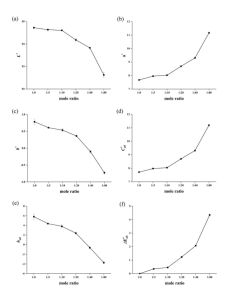
Figure 1. The CIELAB parameters(▲L*,▲a*,▲b*,▲C*ab,▲h*ab and▲E*ab ) of model wine solution with malvidin-3-O-glucoside/gallic acid at different mole ratio
图1. 模拟酒中二甲花翠素-3-O-葡萄糖苷/没食子酸在不同比例下的CIELAB参数
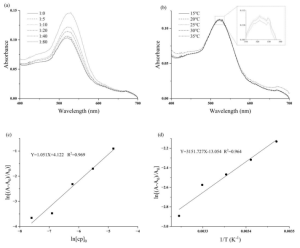
Figure 2. Visible absorption spectra of model wine solution: at 293 K with different mole ratio of malvidin-3-O-glucoside/gallic acid (a); with mole ratio of 1:40 at the temperature ranging from 15 to 35℃ (b). Plots of ln[(A-A0)/A0] vs ln[CP]0 for the copigmentation reactions (c); and plots of ln[(A-A0)/A0] vs (1/T) for the copigmentation reactions (d)
图2. 模拟酒中二甲花翠素-3-O-葡萄糖苷/没食子酸在不同比例(a)和不同温度(b)下的可见吸收光谱;辅色反应根据ln[(A-A0)/A0] vs ln[CP]0(c)和ln[(A-A0)/A0] vs (1/T)(d)的回归方程计算热力学参数。monstrate the chroma and hue fo
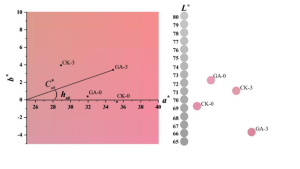
Figure 3. Colorfulness distribution (left panel, L*=60), lightness distribution and feature color (right panel) of real wines with (GA) and without (CK) exogenous addition of gallic acid before fermentation, detected after 0 month and 3 months aging (polar coordinates C*ab and hab demonstrate the chroma and hue for each wine sample)
图3. 对照组(CK-0,CK-3)与没食子酸处理组(GA-0,GA-3)酒样的颜色特征图。
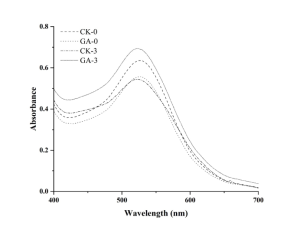
Figure 4. Visible absorption spectra of real wines with (GA) and without (CK) exogenous addition of gallic acid before fermentation, detected after 0 month and 3 months aging
图4. 对照组(CK-0,CK-3)与没食子酸处理组(GA-0,GA-3)的可见吸收光谱图
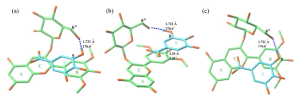
Figure 5. Front (a), side (b) and top (c) views of the most stable conformer 6 of the complex of malvidin-3-O-glucoside/gallic acid (a,b,c). A tube molecular representation is adopted. Carbon atoms are colored in green for malvidin-3-O-glucoside and in cyan for gallic acid. Oxygen and hydrogen (involved in hydrogen bonds) atoms are depicted in red and blue, respectively. HBs, presented in blue dashed lines, are exhibited with key parameters. The stacking distance and dihedral between malvidin-3-O-glucoside rings and gallic acid ring are also included
图5. 二甲花翠素-3-O-葡萄糖苷/没食子酸复合物最稳定构象 6 的正视图(a)、侧视图(b)和俯视图(c)。
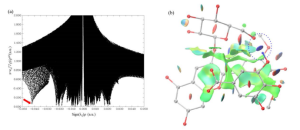
Figure 6. Visualization of non-covalent interactions in complex 6 of the complex of malvidin-3-O-glucoside and gallic acid (a, b). (a) is a plot of the reduced density gradient versus the electron density multiplied by the sign of the second Hessian eigenvalue. (b) is the gradient isosurface (s=0.5 au), which is colored on a blue-green-red scale according to values of sign(λ2)ρ, ranging from -0.02 to 0.02 au. Blue indicates strong attractive interactions, and green indicates weak interactions, and red indicates strong non-bonded overlap
图 6. 二甲花翠素-3-O-葡萄糖苷/没食子酸复合物 6 中非共价相互作用的可视化(a,b)。(a)是还原密度梯度与电子密度乘以第二个 Hessian 特征值符号的关系图。(b) 是梯度等值面(s=0.5 au),根据符号(λ2)ρ的值从-0.02 到 0.02 au以蓝绿红三色标示。蓝色表示强吸引力相互作用,绿色表示弱相互作用,红色表示空间位阻效应
